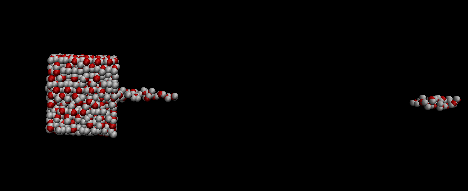Dear all,
Sorry for my repeatative query.
A few days ago, I asked a question about bidirectional motions of water
molecules inside CNT. Andrew did favor and explain that it might come from
that the model (A reservoir+CNT) did not reach equiulbration with constant
pressure.
I just mentioned in passing that it would be a good idea to equilibrate the liquid under constant pressure before you simulate water flowing through the nanotube.
But, to be clear, this is not the reason you have water entering the nanotube.
That would happen anyway.
He suggested me an example that I tested it but it does not work
for my model.
I am using NVE ensemble in conjection with DPD thermostat to keep constant
temperature. I applied an external force on water molecules with “fix
addforce ” command only in Z direction (pore axis). After simulation I see
that water molecules enter the pore from both ends (The attached) instead of
having an unidirectional motion. Actually, I would like to have an
unidirectional motion.
In my previous email I was trying to convey that I don’t think unidirectional motion would be realistic. The water is going to enter the tube from both sides (assuming there is water present on both sides) because of surface tension.
However after this occurs, I would expect that if you continue to apply force to the water molecules (either using fix addforce or fix wall/piston, or something similar, then water would eventually flow from one side of the tube to the other side. (See below)
Actually, I could catch it that to apply a costant pressure by
using a piston on water molecules the “fix aveforce ” command might be used
. But for my case I could not be succeeded.
Could you please let me know how I can do that?
If you keep running the simulation for a longer period of time, I suspect you will eventually see water molecules slowly traveling from one side of the tube to the other. You can attempt a very crude (order of magnitude) estimate the rate at which the water molecules should be flowing using:
https://en.wikipedia.org/wiki/Hagen%E2%80%93Poiseuille_equation
…And I suspect that the water would flow through the tube at a rate much slower than the rate at which it entered the tube initially.
I tried using “fix NPT” instead
of NVE , but the volume (simulation box) is changed.
That is what is supposed to happen…
(Even so, it is not always easy to get it to converge to the correct volume.)
Eventually, if you plan to publish this work, you will need to choose a realistic box size for the number of water molecules in your system. Running an NPT simulation is how you can do do that. However if you are doing this a class assignment and you need a quick result, then perhaps you can get away with estimating the box size by calculating the total volume available to the water in the box and in the tube, and knowing the density of real bulk water. In any case, I would start with that, and worry about pressure equilibration later. (Performing pressure-equilibration simulations in the presence of a large rigid obstacle is not trivial. I suggest you get the other aspects of your simulation working before tackling this issue.)
Andrew
